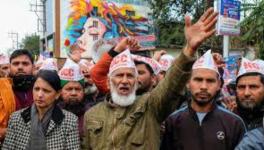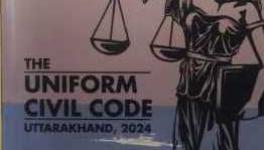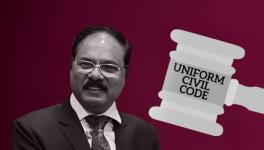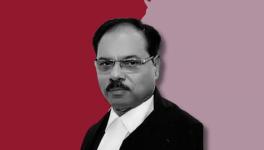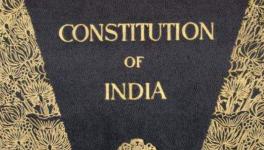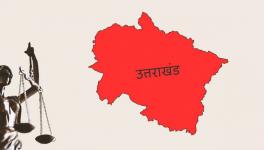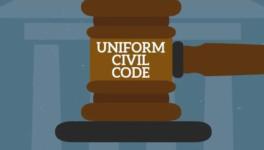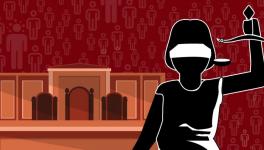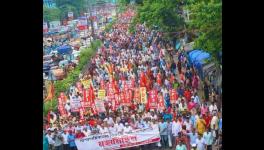Not Hindus, History and Sanity are in Danger in India
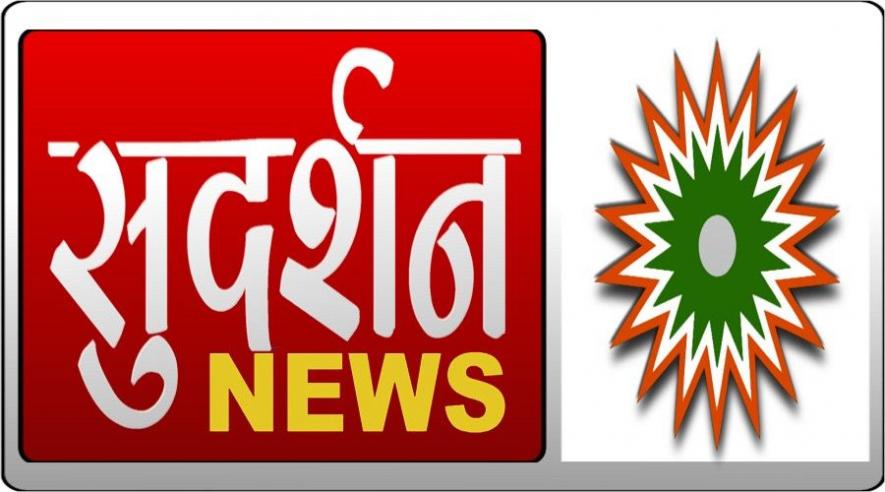
Image Courtesy: Live Law
Sudarshan News, a Hindi language TV channel infamous for spreading communal propaganda and hate speech, recently invented “bureaucracy jihad” in reference to the selection of 42 Muslim candidates in the prestigious UPSC exam. The channel released a video promo for a show on the topic, which went viral, and petitions were filed in the Delhi High Court and Supreme Court against its telecast. Evident from the promotional video was that the selection of Muslims after a competitive exam and interview was seen by the channel as a threat to Hindus and India. The show was not aired, but that does not mean the “Hindu khatre me hai—Hindus are in danger” narrative is under wraps.
In the six years of BJP rule the “Hindu khatre me hai” trope has become a recurrent propaganda tool. It is being applied to the present (as Sudarshan News did anyway) and retrospectively to Indian history, the medieval era in particular. Just like the fake news about Hindus leaving Kairana town in western Uttar Pradesh due to alleged oppression by its Muslim residents was circulated in 2016, any period when a Muslim was at the helm of power is distorted through the “Hindus are in danger” lens. More egregious crimes, like the lynching in Palghar, are not the only arsenal in this narrative. Any act in which a perpetrator happens to be a Muslim and the victim Hindu is subsumed within the “Hindu khatre me hai” notion.
The objective of the communal right-wing forces is to create fear psychosis among the majority community and prop up the improbable idea that a monolithic Hindu identity once existed. The goal is to create a political Hindu entity which can serve up electoral gains to the ruling party. But though it may seem so, the idea of “danger” to Hindus is not a new one. It is one of the biggest weapons in the Hindutva propaganda toolkit, and one of its oldest. “Hindu khatre me hai” is a master narrative which subsumes other minor, but equally prevalent, themes and tropes that operate independently. These tropes include the oversimplification and exaggeration of the religious sanction for Muslim men to marry four women. Hindutva incorrectly argues that this amounts to a fiat for polygamy and is the reason for, on average, the higher Muslim fertility rates. Stretched to incredulous levels, this argument posits that the Muslim population will overtake that of Hindus. This assertion is coupled with the accusation that Muslims want to increase their numbers, and to do so indulge in “love jihad”. Muslim men are therefore projected as more violent and aggressive, and the Hindus as weak and fearful.
Thus follow the absurd ideas of “land jihad” by Muslims, who own less land than any other social group except the Christians and other minorities, “economic jihad” by the Muslims, who are among the worst-off in India, “education jihad” by one of the least-educated social groups. These are creations of the Hindutva fantasy world, which projects Muslims as outsiders who conspire to put 79.8% of the “united” Hindus in existential threat.
“Hindu khatre me hai” is based on a cooked-up sense of victimhood and threat, but becomes a justification for violent aggression in “self-defence”. It pushes the view that there is a two-fold threat to Hindus. The first is demographic or in terms of the number of Hindus versus Muslims. The second is in terms of a larger threat to whatever the Hindutva groups may propagate as “Hindu culture”.
It is the census exercise of the 19th century which enumerated and classified the population along religious lines. At the time, there existed no single understanding of what constitutes being Hindu. It is caste that subsumed religious identity, and this gave the early census officials an extremely difficult time. They struggled to ascertain religious identities, especially of those whom we today call Hindus. During the census exercise (1871-1901), elite caste census officials did not consider the untouchables as Hindus. The Minto Morley reforms undertaken in 1909, after which the franchise was extended to include a variety of communities, the idea of a “Hindu” demographic started to take shape. As did the prospect of losing a demographic battle against Muslims. Once this prospect loomed before the caste Hindu leaders, they started seeking inclusion of the formerly untouchable communities within the Hindu fold. To conceal the inequalities inherent in the caste society, they began spreading the idea that the British, through the Census, were trying to “divide” Hindus.
The 1901 Census became the basis of the “Hindu khatre me hai” discourse, for it revealed a decline in the growth rate of the Hindu population. This was no decline, but simply the exclusion of untouchables and tribal groups who were not seen as Hindus by the census officials. Yet the same elites who were beneficiaries of this exclusion now propagated imaginary apocalyptic visions of annihilation of Hindus. Based on the 1901 Census, Colonel UN Mukherjee published a series of articles in the “Bengali” in 1909, which were later compiled in a pamphlet titled “Hindus: A Dying Race”. It cited the usual high fertility rate and polygamy, in conjunction with religious conversion, to make the fallacious claim that Hindus would be wiped out in 420 years. Mukherjee’s tract is a foundational text of the Hindutva movement, inspiring many such writings by Hindu communal leaders.
The influential Arya Samajist Swami Shraddhanand met Mukherjee, after which he wrote Hindu Sangthan: Saviour of Dying Race in 1926. Shraddhanand argued, “While Muhammadans multiply like anything, the numbers of the Hindus are dwindling periodically.” In 1938, RB Lalchand of Punjab wrote Self-abnegation in Politics in which he argued that the Hindus have “no outside friends and sympathisers... Hindu nationality and Hindu sentiments were being gradually obliterated...”
Suresh Chavhanke, the controversial editor of Sudarshan TV, can claim to be a modern-day legatee of this illogical tradition.
Census-based demographics became a founding principle of Hindu communalism and the entire politics of the Hindu Mahasabha and the RSS remain overcome by this single concern. Reconversion programs were undertaken, Dalits and tribals were prevented from conversion, but still the monolithic Hindu community would not come about, because the fundamental flaw in the project was their Brahmanical bent. Also, several erstwhile untouchable communities refused to be lumped together as “Hindus” and these tensions peaked during the struggle for separate electorates launched by BR Ambedkar, which Mahatma Gandhi and Madan Mohan Malviya resisted, which culminated in the 1932 Poona Pact.
Even after Independence, the obsession with demography remained the Hindu communalist’s top concern. In 1979, the All India Hindu Mahasabha published They Count their Gains, we Calculate our Losses, lifting a phrase from Mukherjee’s book as the title, but wrongly attributing it to Bhai Parmanand, a Hindu Mahasabha leader who had proposed Partition on religious lines in 1908-09. The bogey of Muslim overpopulation was raised in this book, by distorting Census data. All the themes explored in the 19th-century books and pamphlets are thriving today and the Sudarshan TV episode is just one more instance of this.
The so-called attack on Hindu culture, beliefs and practices by a westernised “left/liberal/secular” academia is another trope whose origin is located in the 19th-century critiques written by colonial administrators, Christian missionaries and indigenous reformists like Ram Mohan Roy, Ishwar Chandra Vidyasagar, and others. Their critiques of prevailing caste and gender-based discrimination, superstitions, religious literature, cultural practices were expressed as “Hinduphobia”.
The imaginary threat, combined with claims of victimhood, plays its most important function of unifying the non-Muslim and non-Christian population into a political body of Hindus. For this reason, the Hindutva ecosystem urges all non-Muslims and non-Christians to gloss over differences of caste and distinctions of region, ethnicity and language, to form a unified Hindu identity and resist the non-existent demographic and cultural threat. The catch is that the inherent Brahmanism of this ecosystem does not allow it to realise a unity in practice. A monolithic Hindu community with a central theme of victimhood at the hands of Muslims immediately implies that Hindus oppressed by another Hindu cannot hope for justice.
Consider the recent vandalism of a Congress MLA's house in Bangalore by a mob of Muslims. The right-wing, which often accuses the Congress of playing “caste politics”, suddenly identified this MLA as a Dalit Hindu under attack from Muslims. Contrast this with countless cases of Dalits victimised by perpetrators who belong to elite caste, where the Hindutva ecosystem never senses a danger to Hindus. The Una lynching victims were never identified as Hindu because the perpetrators belonged to the upper and dominant castes. So in the real world, the “Hindu khatre me hai” discourse only stalks Muslims or other minorities, which casts them in the role of instigator. In all other situations, the traditional caste and gender hierarchy is upheld, but this is never acknowledged as a threat to the unified political Hindu body—or to the vision of equality before the law.
As another decennial census is on the horizon, religion-based demographic numbers are sure to be played up so that the politics of the next decade can remain in the grip of communalists. The clamour for population control, Uniform Civil Code and the NRC-CAA are preparations for intensified communal discourse, and these need to be countered no matter what.
The author is a PhD candidate at Centre for the Study of Social Systems, JNU. The views are personal.
Get the latest reports & analysis with people's perspective on Protests, movements & deep analytical videos, discussions of the current affairs in your Telegram app. Subscribe to NewsClick's Telegram channel & get Real-Time updates on stories, as they get published on our website.









